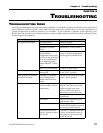
Operation: Chapter 3
22 RA150/300/500 Reference Manual
PROTECT/CLIP INDICATORS
Clip lights for each channel indicate the onset of
actual clipping. Even if the problem occurs for only
a few microseconds, a pulse-stretching circuit will
allow the LED to light long enough for you to see
that a problem is occurring.
Because of the RA150/300/500’s ability to enter
and exit clipping with as few audible artifacts as
possible, you may not hear any distortion even if
the indicator flashes. In general, a few flashes every
now and then will not be a problem. However, if
the LEDs flash often or remain on for any extended
period of time, then turn down the volume controls
to reduce the signal level going to the
RA150/300/500. If this doesn’t solve the problem,
check your output cables and speakers.
METERS (RA300 AND RA500
ONLY)
In the center of the front panel are two meters that
show the total power output of each channel. The
highest (red) LED indicates the unit is at maximum
output, at the onset of clipping. The orange
PROTECT LEDs come on when the unit is 6 dB
below rated output. Operation with the PROTECT
LED on continuously will lead to amplifier
overheating and eventual thermal shutdown to
protect the circuitry. The two green LEDs closest to
the PROTECT LED will actually light at higher
levels than –6 dB, but before clipping. Lower green
LEDs indicate signal in a normal operating range.
No LEDs will light if the amplifier is operating 33
dB or less below maximum rated output.
The PROTECT LEDs will light in two other cases:
• For 4.5 seconds at initial turn-on while the
output relay is connected.
• When the thermal protection circuitry is
activated because the amplifier is
overheating. Thermal protection will stop
automatically when the amplifier cools
down.
BACK PANEL CONTROLS
AC VOLTAGE SWITCH
Located near the power inlet is a recessed switch
that allows voltage conversion from 120 volt to
230 volt operation. Use a small tool or pen to
change the setting of this switch only if it is set to
the wrong value for the country the amplifier will
be used in.
When changing voltages the fuse must be
changed to the correct rating as shown
on page 10.
STEREO/BRIDGED MONO SWITCH
Underneath the right input jack, this switch
converts the RA150/300/500 from its normal
operation as a two-channel amplifier to operation
as a single-channel amplifier with approximately
twice the power. Make sure this switch is set
properly for your application. See page 20.
If this switch is accidentally switched to Mono
while wired for stereo, you will hear
out-of-phase audio as the Channel
2/Right control is turned up.
CHECKING FOR PROPER
POLARITY
To check for correct speaker polarity, briefly
connect the + terminal of a 1.5V battery to the
speaker cable’s “hot” or + lead, and the battery’s
- terminal to the speaker cable’s “cold,” ground,
or - lead. You will hear a “pop” from the
loudspeaker as you connect the battery, and
another as you disconnect it. Observe the
direction of the speaker cone movement. If the
speaker cables are wired in the common manner
(and the speakers themselves are not
mislabelled), the speaker cone will move forward
(toward you) when you connect the battery and
away from you when the battery is disconnected.
If the speaker cone moves in the opposite
direction, reverse the wires going to the speaker
and re-test for proper polarity. Always check
your speakers' polarity as not all manufacturers
follow the same wiring convention.


















